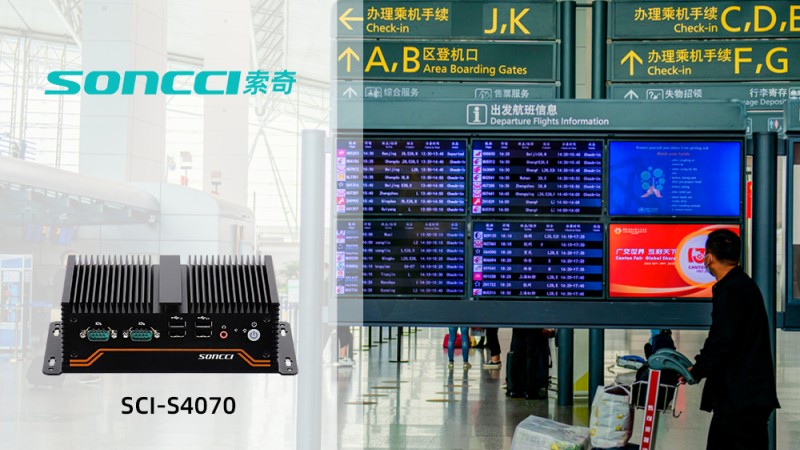
Industrial computers play a vital role in the Flight Information Display System (FIDS). As an important part of the normal process of ensuring passengers, FIDS is an important means for airports to provide public services directly to passengers, and at the same time, it is also a window for communication between airports and passengers.
The central role of industrial computers in FIDS
The main function of FIDS is to display flight information, announcement information, service information, etc. released to the public with a variety of mainstream display equipment as the carrier, and provide timely, accurate and friendly information services for passengers, building staff and airline ground agents. FIDS projects require high-performance and stable industrial computers to process high-resolution images, video advertisements, and some text data to provide real-time display information. The computer was designed to be as small as possible and could be mounted in a variety of ways to integrate with monitors of different sizes. In addition, it needs to withstand high temperatures in an enclosed space and operate stably without a fan with low power consumption, ensuring trouble-free operation 24/7.
Technical characteristics and advantages of industrial computer
High performance and stability: The industrial computer uses high-performance processors and large-capacity memory to ensure that the FIDS system processes and displays flight information in real time and accurately. At the same time, its stable hardware platform can ensure the long-term trouble-free operation of the system and meet the airport's high reliability requirements for flight information display.
Compact and flexible: In order to meet the space requirements of FIDS systems, IPCs usually have a compact design with a small size for easy installation and deployment. In addition, the IPC also supports a variety of installation methods, such as embedded installation, wall mounting, etc., to adapt to different application scenarios.
Fanless design: In order to ensure that it can withstand high temperatures in confined spaces, the industrial computer adopts a fanless design, and the heat dissipation structure is optimized to achieve low power consumption and high efficiency heat dissipation. This not only reduces the noise of the system, but also improves the stability and service life of the system.
Rich interfaces and expandability: The industrial computer provides a wealth of input and output interfaces, such as USB, network port, VGA, HDMI, etc., which is convenient for connection and data transmission with other devices. At the same time, the industrial computer also supports a variety of expansion modules, such as wireless network cards, Bluetooth modules, etc., to meet the needs of FIDS system for wireless communication.
The specific application of industrial computer in FIDS
Real-time update and display of flight information: The industrial computer receives the real-time flight information transmitted by the flight data interface, and displays it on LED, LCD and other display devices after processing. Passengers can use these displays to know the arrival of flights, departure times, boarding gate locations, and other information.
Multi-screen display and query: The IPC supports multi-screen display function, which can display flight information on multiple display devices simultaneously. Passengers can view flight information at different locations and check detailed flight information through information inquiry terminals or mobile applications.
Provide boarding gate navigation information: The IPC can display the location information and navigation guidance of the boarding gate to help passengers quickly find their flight boarding gate. This will not only improve the travel efficiency of passengers, but also reduce the work pressure of airport staff.
Integrate other extended services of the airport: IPC can also be integrated with other airport service systems, such as baggage check-in, security channels, etc. Passengers can use the FIDS system to know the specific location and use of these services, so as to facilitate the relevant procedures.
High performance and fanless design
Powered by intel Celeron/Core processors, the SCI-S4070 delivers high performance for fanless operation at low power consumption, making it ideal for high-end and low-power embedded applications.
Small size and flexible installation
With its space-saving design (206×125×62mm) and flexible mounting options (embedded, wall-mounted, desktop), the SCI-S4070 can be easily integrated into displays of different sizes under any complex installation conditions.
Wide operating temperature
To prevent overheating during operation under harsh conditions, the SCI-S4070 supports a wide temperature range of -10°C~60°C to ensure uninterrupted operation.
Features:
● Support intel Celeron/Core i3, i5, i7 processors, integrated intel core graphics card
● Support 1 SO-DIMM DDR3/4 memory slot, mSATA, M.2 SSD
● 2 Gigabit Ethernet ports, support network wake-up, diskless boot, built-in SIM card slot, optional WIFI/Bluetooth/4G module
● 6 RS232 DB9 COM serial interfaces, COM1-2 support RS485 switching, HDMI+VGA dual display output
● BIOS supports Watchdog hardware reset, power-on and power-on function
● Compact and sturdy fully sealed aluminum alloy chassis and large-area aluminum fin fanless heat dissipation structure, wide temperature (-10 ~ 60°C) stable operation
● Mini and small is only the size of the palm of your hand, the host is black/silver optional, and supports embedded, wall-mounted, and desktop installation










Leave a comment